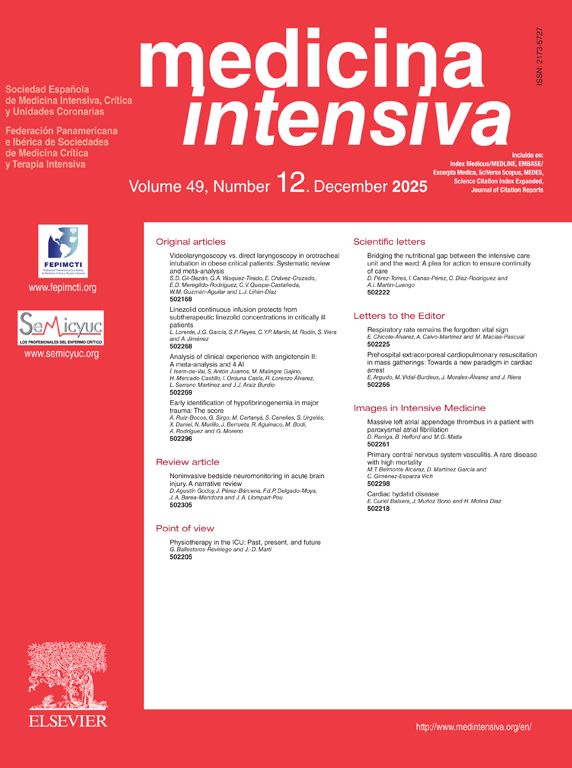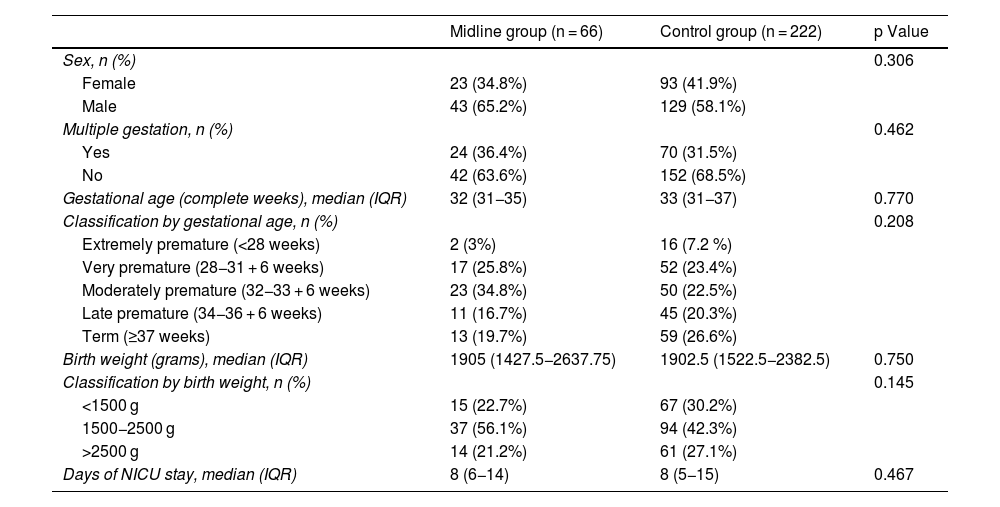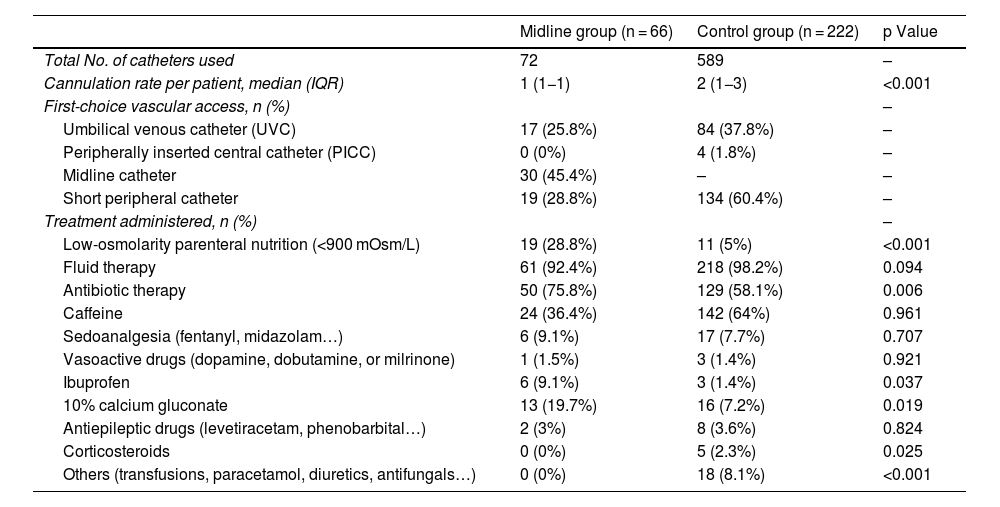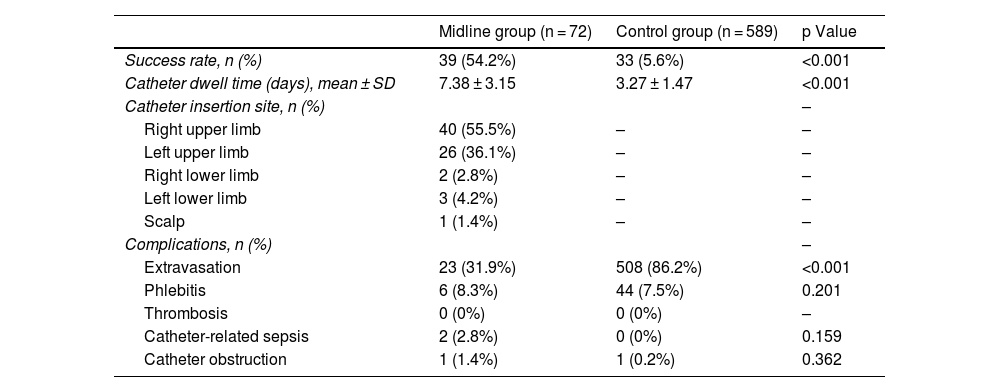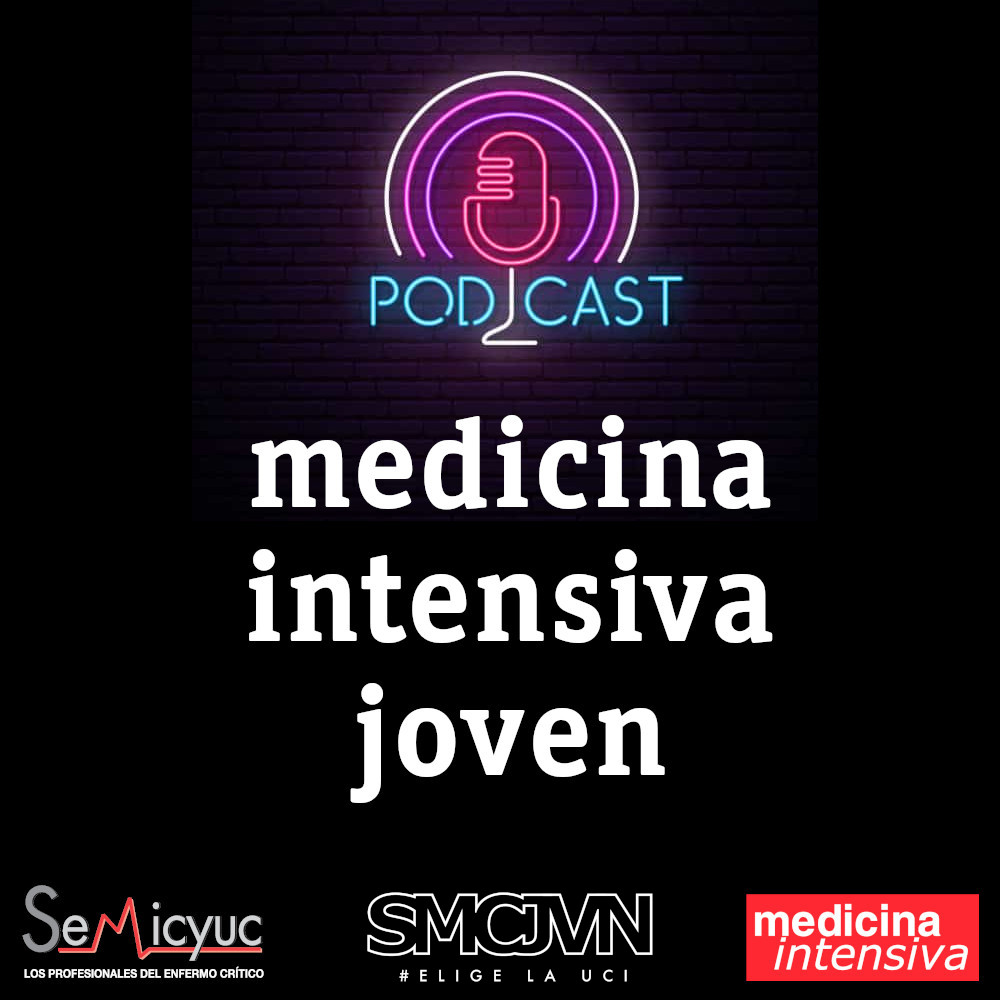Analyze the usefulness of the midline catheter in terms of efficacy and safety for treatments lasting more than 3 days in the neonatal population requiring admission to the NICU.
DesignAnalytical and observational of a prospective cohort (December 2021–November 2023) compared to a historical cohort (January 2020–November 2021).
Setting9-bed Neonatal Intensive Care Unit (NICU, level III hospital.
Patients or participants288, 66 midline group and 222 control group. Inclusion criteria: newborns from 24 to 42 weeks of gestation who required short peripheral or midline cannulation and treatment longer than 3 days.
InterventionsFollow-up during NICU stay and comparison with retrospective data from a historical cohort.
Main variables of interestSociodemographics, success rate (permanence of the same vascular catheter without complications until finish the prescribed treatment), number of catheters, cannulation rate per patient, indwell time, complications.
ResultsThe midline group showed a higher success rate (54.2% vs 5.6%, p < 0.001), a lower number of canalizations per patient (p < 0.001), a longer indwell time (p < 0.001) and a lower number of extravasations (p < 0.001).
ConclusionsThe midline catheter has advantages over short peripheral catheters, being a useful alternative in terms of efficacy and safety for treatments lasting more than 3 days in the neonatal population that requires admission to the NICU.
Analizar la utilidad del catéter midline en términos de eficacia y seguridad para tratamientos con una duración superior a 3 días en la población neonatal que precisa ingreso en UCIN.
DiseñoObservacional analítico de una cohorte prospectiva (diciembre 2021-noviembre 2023) comparada con una cohorte histórica (enero 2020-noviembre 2021).
ÁmbitoUnidad de Cuidados Intensivos Neonatales (UCIN), 9 camas, hospital nivel III.
Pacientes o participantes288, 66 grupo midline y 222 grupo control. Criterios de inclusión: recién nacidos de 24 a 42 semanas de gestación que precisaron canalización de vía periférica corta o de midline y tratamiento superior a 3 días.
IntervencionesSeguimiento durante estancia en UCIN y comparación con datos retrospectivos de cohorte histórica.
Variables de interés principalesSociodemográficas, tasa de éxito terapéutico (permanencia de un mismo catéter vascular en ausencia de complicaciones hasta la completa finalización del tratamiento pautado), número de catéteres, tasa de canalizaciones por paciente, tiempo de permanencia del catéter, complicaciones.
ResultadosEl grupo midline presentó mayor tasa de éxito terapéutico (54.2% vs 5.6%, p < 0.001), menor número de canalizaciones por paciente (p < 0.001), mayor tiempo de permanencia del catéter (p < 0.001) y menor número de extravasaciones (p < 0.001).
ConclusionesEl catéter midline presenta ventajas respecto a los catéteres periféricos cortos, siendo una alternativa útil en términos de eficacia y seguridad para tratamientos con una duración superior a 3 días en la población neonatal que precisa ingreso en UCIN.
In neonatal intensive care units (NICUs), it is essential to obtain adequate vascular access to ensure nutritional and therapeutic support for patients. This is not always easy to do due to the extreme fragility of their veins, making the choice of the most appropriate catheter for each patient crucial for their progress. This choice should not only be based on the need for rapid access but also on mid- and long-term factors such as the expected duration of treatment and the physical and/or chemical characteristics of the therapy.1
Central venous catheters are IV devices that reach the central circulation by placing their tip in the superior or inferior vena cava. Their use is preferred when long-term therapies are required due to their extended dwell time or when drugs or other components with high osmolarity and irritant effects need to be administered. Placement of these catheters requires trained nursing staff and imaging tests such as X-rays or ultrasounds to confirm their correct position.2 Additionally, their use is not without complications such as catheter-related bacteremia, thrombosis, arrhythmias, or cardiac tamponade.3
On the other hand, the most widely used vascular access in NICUs are short peripheral catheters or peripheral lines, whose main advantage over the central ones is their easier placement. However, multiple cannulations are sometimes needed due to the high rate of extravasations and other complications such as phlebitis, which often occur before completing the prescribed treatment.4
Midline catheters are long peripheral catheters (4 cm up to 30 cm) that offer an alternative between the short lifespan of short peripheral catheters3 and the invasive nature of central lines. Their tip is positioned in a larger-caliber vessel area, where there is greater blood flow and speed, ideally between the axillary and subclavian veins, and outside the abdominal cavity in the case of the lower limbs, without requiring radiological confirmation. This promotes greater hemodilution of infusions and drugs, which is particularly beneficial for treatments with greater vesicant effect, pH between 5 and 9, and non-hyperosmolar therapies,5 producing less mechanical and/or chemical irritation,4 also favored by the high biocompatibility of polyurethane (PUR) with the venous intima, a fundamental characteristic of this material. Their mean dwell time is estimated to be around 9 days,6 although PUR can be used for up to 4 weeks, which is associated with higher therapeutic success rates and fewer cannulations.7 These characteristics make them a noteworthy option primarily for treatments lasting more than 6 days according to clinical practice guidelines.5,8 However, considering the limited venous capital of the neonatal population and the short duration of short peripheral catheters, with the increase in the number of venipunctures and, consequently, painful and stressful stimuli for the patient, the use of midline catheters could be considered in neonates requiring treatments longer than 3 days.9
Although blood draws are not an indication per se for the placement of a midline catheter, in clinical practice, this vascular access can be used for this purpose, taking advantage of its permanence to reduce venipunctures, thereby minimizing the alteration of the patient's venous capital and the associated pain, which is especially important in this population. Although scientific evidence is scarce in this regard, clinical experience indicates that if strict maintenance protocols are followed and variables such as the catheter diameter, material, and tip location are considered, blood draws are possible and appropriate with a low associated hemolysis rate.10
The use of midline catheters is well studied in adult and pediatric populations,6,11–13 proving to be a useful alternative to short peripheral catheters, due to their longer dwell time, and to central catheters, as they are associated with fewer complications.7 However, experience in neonates is more limited, although there are studies comparing their advantages and disadvantages to other devices used in NICUs such as peripheral lines.7,14
In our unit, the use of midline catheters was implemented in December 2021. We use class IIa polyurethane catheters, 2 French in diameter (Seldipur Smartmidline®, Vygon), 8 cm and 10 cm in length, inserted using Seldinger or MicroSeldinger techniques, with or without ultrasound guidance, by the nursing staff.
Given the profile of the midline catheter as a safe and effective vascular access in NICUs, the hypothesis proposed is that midline catheters are a useful alternative to short peripheral catheters in patients admitted to the intensive care unit for treatments lasting more than 3 days.
The general objective of this study is to analyze the utility of the midline catheter in terms of safety and efficacy for treatments lasting more than 3 days in the neonatal population requiring admission to the NICU.
Regarding specific endpoints, the main endpoints as to compare the therapeutic success rate between the midline catheter and short peripheral catheters. This rate is defined as the permanence of the same vascular catheter without complications until the complete conclusion of the prescribed treatment. Secondary endpoints include comparing the number of cannulations, the catheter dwell time, and the incidence of complications in the midline group vs the short peripheral catheter group. Additionally, the study aims to define the clinical and/or sociodemographic variables of patients eligible for midline catheter indication.
The study includes newborns from 24 to 42 weeks of gestation, regardless of their postnatal age, who required admission to the NICU and cannulation of a short peripheral or midline catheter.
Patients who did not require vascular access or whose duration was <3 days, as well as those who did not obtain informed consent, were excluded.
Patients and methodsStudy designWe conducted an analytical observational study of a prospective cohort and compared it with a historical cohort. Data collected from patients who had midline catheters used are analyzed.
Study populationA total of 66 patients who had midline catheters inserted between December 2021 and November 2023 in the NICU of Hospital General Universitario of Elche, Spain—the midline group—were included. The decision to insert one type of catheter over the other was left to the to the specialist’s criterion. A cohort of neonates with peripheral lines inserted from January 2020 through November 2021 was selected as the control group. During this period, midline catheters were not used in the unit. This group includes a total of 222 patients.
Number and samplingSample size calculation was performed using the Epidat v. 4.2 software. Assuming a statistical power of 80% and a confidence level of 95% to detect an inter-group 40% difference in success rate, a sample of 48 patients was thought to be necessary. A non-probabilistic sampling technique was used, with consecutive case selection for both the midline and the control group.
Data analysisStatistical analysis is performed using IBM's SPSS v. 25 software. Median and mean were used as measures of central tendency, depending on the sample distribution and type of variable. Standard deviation and interquartile range (IQR) were used as measures of dispersion. An analysis per protocol is conducted for both the primary and secondary variables. For the comparison of means or medians, the chi-square test, analysis of variance (ANOVA), the Mann–Whitney U test, and independent samples t-test were used depending on the sample distribution. To assess the relationship between the primary variable (success rate) and the other described variables, a bivariate analysis using binary logistic regression is performed for each variable. p Values < 0.05 were considered statistically significant.
LimitationsThe insertion of midline catheters is a technique that requires training of the NICU nursing staff and thus presents a learning curve. Its recent implementation in the unit may negatively impact the frequency of complications and extravasations, so the success rate of midline catheters could be even higher.
Additionally, we had the inherent limitations of a study with a historical and observational cohort. Therefore, a randomized clinical trial could address this issue.
Ethical aspectsThe project was approved by the Research Ethics Committee (CEIm) of Hospital General Universitario of Elche, Spain (report 07/2022).
ResultsA total of 288 patients were collected, 66 which (22.9%) were included in the midline group and 222 (77.1%) in the control group.
The baseline characteristics of the patients, including sex, gestational age, and birth weight, were similar in both groups with no statistically significant differences being reported. There was a higher number of male patients in both groups, with a median gestational age of 32 weeks in the midline group and 33 weeks in the control group, and a mean birth weight of 1905 g and 1902 g respectively. The median length of NICU stay was 8 days in both groups (Table 1).
Patient characteristics.
| Midline group (n = 66) | Control group (n = 222) | p Value | |
|---|---|---|---|
| Sex, n (%) | 0.306 | ||
| Female | 23 (34.8%) | 93 (41.9%) | |
| Male | 43 (65.2%) | 129 (58.1%) | |
| Multiple gestation, n (%) | 0.462 | ||
| Yes | 24 (36.4%) | 70 (31.5%) | |
| No | 42 (63.6%) | 152 (68.5%) | |
| Gestational age (complete weeks), median (IQR) | 32 (31−35) | 33 (31−37) | 0.770 |
| Classification by gestational age, n (%) | 0.208 | ||
| Extremely premature (<28 weeks) | 2 (3%) | 16 (7.2 %) | |
| Very premature (28−31 + 6 weeks) | 17 (25.8%) | 52 (23.4%) | |
| Moderately premature (32−33 + 6 weeks) | 23 (34.8%) | 50 (22.5%) | |
| Late premature (34−36 + 6 weeks) | 11 (16.7%) | 45 (20.3%) | |
| Term (≥37 weeks) | 13 (19.7%) | 59 (26.6%) | |
| Birth weight (grams), median (IQR) | 1905 (1427.5−2637.75) | 1902.5 (1522.5−2382.5) | 0.750 |
| Classification by birth weight, n (%) | 0.145 | ||
| <1500 g | 15 (22.7%) | 67 (30.2%) | |
| 1500−2500 g | 37 (56.1%) | 94 (42.3%) | |
| >2500 g | 14 (21.2%) | 61 (27.1%) | |
| Days of NICU stay, median (IQR) | 8 (6−14) | 8 (5−15) | 0.467 |
IQR, interquartile range.
A total of 72 midline catheters and 589 peripheral lines were placed (Table 2). Significant differences were found in the rate of cannulations per patient, with a median and IQR in the midline group of 1 (1-1) and in the control group of 2 (1-3).
Catheters and therapies used per patient.
| Midline group (n = 66) | Control group (n = 222) | p Value | |
|---|---|---|---|
| Total No. of catheters used | 72 | 589 | – |
| Cannulation rate per patient, median (IQR) | 1 (1−1) | 2 (1−3) | <0.001 |
| First-choice vascular access, n (%) | – | ||
| Umbilical venous catheter (UVC) | 17 (25.8%) | 84 (37.8%) | – |
| Peripherally inserted central catheter (PICC) | 0 (0%) | 4 (1.8%) | – |
| Midline catheter | 30 (45.4%) | – | – |
| Short peripheral catheter | 19 (28.8%) | 134 (60.4%) | – |
| Treatment administered, n (%) | – | ||
| Low-osmolarity parenteral nutrition (<900 mOsm/L) | 19 (28.8%) | 11 (5%) | <0.001 |
| Fluid therapy | 61 (92.4%) | 218 (98.2%) | 0.094 |
| Antibiotic therapy | 50 (75.8%) | 129 (58.1%) | 0.006 |
| Caffeine | 24 (36.4%) | 142 (64%) | 0.961 |
| Sedoanalgesia (fentanyl, midazolam…) | 6 (9.1%) | 17 (7.7%) | 0.707 |
| Vasoactive drugs (dopamine, dobutamine, or milrinone) | 1 (1.5%) | 3 (1.4%) | 0.921 |
| Ibuprofen | 6 (9.1%) | 3 (1.4%) | 0.037 |
| 10% calcium gluconate | 13 (19.7%) | 16 (7.2%) | 0.019 |
| Antiepileptic drugs (levetiracetam, phenobarbital…) | 2 (3%) | 8 (3.6%) | 0.824 |
| Corticosteroids | 0 (0%) | 5 (2.3%) | 0.025 |
| Others (transfusions, paracetamol, diuretics, antifungals…) | 0 (0%) | 18 (8.1%) | <0.001 |
IQR, interquartile range.
The midline catheter was selected as the first vascular access in 30 patients (45.5%). In the remaining cases, it was cannulated after the first line was removed: in 17 cases a central line (25.8%) and in 19 cases a peripheral line (28.8%). In the control group, the short peripheral catheter was considered the first option in 134 patients (60.4%). In the remaining 88 cases (39.6%), it was cannulated after the removal of a central line.
Regarding the treatments administered in both groups, statistically significant differences were found in the administration of parenteral nutrition, antibiotic therapy, ibuprofen, and 10% calcium gluconate, which were more frequently used in the midline group; as well as in the administration of corticosteroids and other therapies (including blood product transfusions, paracetamol, antifungals…), which were more widely used in the control group.
The bivariate analysis of the success rate in the midline group showed no statistically significant relationship with any of the studied variables (gestational age, birth weight, catheter insertion site, and administered treatment).
A success rate of 54.2% was obtained in the midline group vs 5.6% in the control group, with this difference being statistically significant (Table 3).
Success rate, dwell time, insertion site, and catheter-related complications.
| Midline group (n = 72) | Control group (n = 589) | p Value | |
|---|---|---|---|
| Success rate, n (%) | 39 (54.2%) | 33 (5.6%) | <0.001 |
| Catheter dwell time (days), mean ± SD | 7.38 ± 3.15 | 3.27 ± 1.47 | <0.001 |
| Catheter insertion site, n (%) | – | ||
| Right upper limb | 40 (55.5%) | – | – |
| Left upper limb | 26 (36.1%) | – | – |
| Right lower limb | 2 (2.8%) | – | – |
| Left lower limb | 3 (4.2%) | – | – |
| Scalp | 1 (1.4%) | – | – |
| Complications, n (%) | – | ||
| Extravasation | 23 (31.9%) | 508 (86.2%) | <0.001 |
| Phlebitis | 6 (8.3%) | 44 (7.5%) | 0.201 |
| Thrombosis | 0 (0%) | 0 (0%) | – |
| Catheter-related sepsis | 2 (2.8%) | 0 (0%) | 0.159 |
| Catheter obstruction | 1 (1.4%) | 1 (0.2%) | 0.362 |
IQR, interquartile range; SD, standard deviation.
The overall mean dwell time of the catheter was 7.38 days and 3.27 days respectively (p < 0.001), reaching statistical significance. The catheter dwell time was analyzed in patients based on the success rate of the therapy, showing significant differences between the midline and the control group both in patients who successfully completed the therapy (mean of 8.85 days vs 4.42 days) and in those who experienced a complication during therapy (mean of 5.24 days vs 3.0 days).
The most frequently observed complication was catheter extravasation, which was lower in the midline group (31.9% vs 86.2%), reaching statistical significance (p < 0.001). No significant differences were seen between groups (p = 0.201) in the incidence of phlebitis (8.3% vs 7.5% respectively). Two cases (2.8%) of catheter-related sepsis by Staphylococcus epidermidis were documented in the midline group, with microbiological confirmation in blood culture and catheter tip, and clinical correlation. No cases of thrombosis, catheter calcification, or catheter breakage were reported. A total of 129 out of the 189 patients (68.3%) from the control group had complications within the first 3 days after catheter placement. The rate of complications was not influenced by the treatment used in either group or by the insertion site in the case of the midline group.
DiscussionIn this study, a statistical comparison was drawn between midline catheters and short peripheral catheters used in our NICU. The midline catheter showed a higher therapeutic success rate and, therefore, fewer cannulations per patient, longer catheter dwell time, and fewer complications associated with its use. These findings indicate that midline catheters are a useful alternative to short peripheral catheters in terms of safety and efficacy for treatments lasting more than 3 days in the neonatal population requiring NICU admission.
The therapeutic success rate of the midline catheter in our study was 54.2%, which is considerably lower than the 71.7% success rate reported by Chenoweth et al. in 2018,7 possibly due to the small sample size in our study (72 and 432 cannulations, respectively) and the fact that we are still in the learning curve. However, we should mention that the patients included in the midline group in that study had a median gestational age of 35.8 weeks and a mean birth weight of 2687 g, representing a population with different characteristics from ours that could have impacted the success rate.
Regarding the dwell time of the midline catheter, our series of 7.38 days (SD, 3.15) shows that other studies conducted in the neonatal population reported more varied dwell times, being 8.5 days (range, 7–10) in the study by Tsunozaki et al., 4.17 days (range, 1–12) in the report by Romitti et al., and 4 days (SD, 2.3) in the study by Chenoweth et al.7,9,14
Similarly, Chenoweth et al. and Tsunozaki et al.7,14 also reported fewer cannulations and a lower rate of complications in patients with midline catheters, highlighting fewer extravasations than with short peripheral catheters.
In the control group, a high incidence of extravasations (86.2%) was observed, which is consistent with the results described in the literature.3 The mean dwell time of the short peripheral catheter in our series was 3.27 days, which is slightly higher compared to other studies.3 However, in 68.3% of patients who did not achieve therapeutic success, complications occurred within the first 3 days after catheter placement, highlighting the clinical interest in considering neonates requiring treatment for more than 3 days as eligible for midline catheterization despite current recommendations reserving the use of this catheter for treatments longer than 6 days.5,8
In the midline group, 2 cases of clinical and microbiological catheter-related sepsis were recorded. Both cases occurred within the first semester after the introduction of the midline catheter in the unit, a period included in the staff training process. Additionally, these were the only 2 cases in which the cannulated catheter length was 10 cm instead of 8 cm, potentially positioning the tip more centrally. It is crucial to create strategies for preventing midline catheter-related sepsis,15 adopting, for example, those used in our unit in the context of the Bacteriemia Zero project,16 such as creating checklists, reviewing the materials used, or ongoing staff training.
In our series, within the midline group, up to 28.8% of patients had previously been inserted with a short peripheral catheter that had to be removed after complications such as extravasation or phlebitis occurred. As shown in our study, patients in the control group had more than twice as many cannulations as patients in the midline group to complete their treatment, highlighting the importance of adequate individualized assessment of each patient regarding the catheter chosen as the first option, checking whether they meet the criteria for midline catheterization, and benefiting from the multiple advantages over peripheral lines.
The use of midline catheters in NICUs represents a significant advance in patient safety and the comprehensive management of newborns. It is a safe, beneficial procedure that respects the neonate's venous capital, allowing the avoidance of multiple punctures and thereby reducing the consequent stress and pain associated with them,1 which is crucial in this population.
The literature review conducted before the protocolized use of the midline catheter in our center is reinforced by the results obtained in this study based on the experience of our unit. The primary indication for midline catheterization is established in patients, regardless of gestational age and birth weight, who are ineligible for central vascular access and require continuous or intermittent IV treatment for more than 3 days. Randomized prospective clinical trials with larger numbers of patients are necessary to draw conclusions on the independent variables that influence the success rate of the midline catheter, allowing for more precise definition of which patients would benefit the most from the cannulation of these catheters based on their clinical and sociodemographic characteristics, such as gestational age or birth weight, as well as based on the treatment required.
ConclusionsThe midline catheter is a useful alternative to short peripheral catheters in terms of safety and efficacy for treatments lasting more than 3 days in the neonatal population requiring NICU admission. The use of the midline catheter is associated with a higher therapeutic success rate and a longer dwell time vs short peripheral catheters, and it also shows a lower number of cannulations per patient and fewer extravasations. In our study, no variables were found to have an impact on the success rate of the midline catheter, so we consider all patients admitted to the NICU is potential candidates for cannulation.
Authors’ contributionsDr. Sánchez García is the lead investigator of this project, as well as the person responsible for the study design, data collection, data analysis, and drafting of this article. Dr. Lozano González actively participated in the study design, data analysis, and manuscript writing. Dr. Canals Candela collaborated conducting the statistical analysis and the manuscript final review.
FundingNone declared.
Conflicts of interestNone declared.

